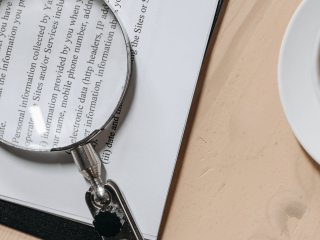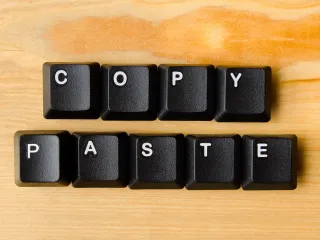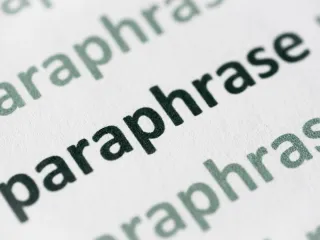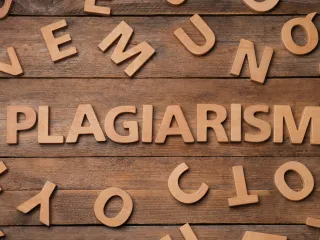Utilizing the ideas from another person’s work in your writing is customary. Sometimes, it’s the only way to adequately support a stance, connect research, and provide the proper context. This is especially true for research papers and other forms of academic writing.
Is summarizing plagiarism? No. Correctly summarizing an author’s ideas without passing them off as your own clears your writing of plagiarism while still applying the necessary backing that concepts from an outside source can provide.
A good summary gives the reader a clear and condensed version of an author’s idea. It strips down a different piece of writing to expose the main points that specifically connect to your paper’s purpose.
When one is asking how to summarize without plagiarizing, the answer lies in applying techniques like carrying out extensive preparation work, rewriting, and using proper citations.
What Is Plagiarism?
Plagiarism is copying or appropriating another person’s work and passing it off as your own, either directly or indirectly. Putting another author’s ideas into your own words requires a careful balancing act to avoid plagiarizing.
Depending on the writing’s circumstances, plagiarizing can have serious legal or academic ramifications. Plagiarizing journalistic material or other professional publications carries potential monetary fines and even jail sentencing.
In the academic realm, plagiarizing research papers can lead to failing the assignment or an entire grade and possibly expulsion. If you are accused of plagiarism in high school it can impact your college admissions status. Aside from external penalties, plagiarizing academic papers hinders creative processes and learning opportunities.
Consequences extend beyond the perpetrator. Plagiarism can negatively impact the reputation of every writer involved. It questions and confuses the research’s origins which jeopardizes the validity of rigorous work done by others.
Proper Summarizing Strategies
Summarizing appropriately is a relatively simple feat when you have a series of techniques to guide the preparation and writing procedures. Here is a short breakdown of methods you can employ when learning how to summarize without plagiarizing.
Prepare for Summaries When Researching
Read the original paper more than once to ensure a thorough understanding of each internal concept. You also bear the responsibility as a writer to accurately represent the original source’s content. Missing or misconstruing information will confuse the argument you’re attempting to support.
Although a summary condenses the original source and provides a wide-ranging synopsis of its content, a comprehensive understanding strengthens your position and written tone.
Take notes of the article’s main points. You need to extract the key points from the information the author presents clearly and concisely summarize. Engage in active reading practices like making notations in the text margins.
Observing the questions you have concerning the source, commenting, and highlighting standout ideas force a deeper involvement with and understanding of the source’s critical information. It’s helpful to take note of the writer’s organization like thesis statements and headings because that’s how authors present main points.
Draft Summaries When Writing
Use your own words when creating an article summary. To avoid plagiarism, you need to work away from including every detail and instead digest the original piece’s essence to say in your voice. A good summary doesn’t imitate the original author, but rather distills the information and expresses it uniquely.
Rewrite everything through acceptable paraphrasing and interpreting in your own manner. Utilizing synonyms alone is not enough. Reconstruct and reorganize the way the ideas appear in the writing to convey a clear idea while maintaining independence from the original source. Keep the intentions for your writing in focus to help create logical transitions between different concepts and supportive arguments that span from source to source.
Avoid direct quotes when performing a text summary. Relying on direct quotations leaves less room for your analysis and interpretation. It also minimizes your opportunity for paraphrasing, which doesn’t require using quotation marks and still conveys source-provided information.
Proofread your article summary to ensure there are no missing quotation marks or other citations that reference the original source. Most plagiarism isn’t malicious, but rather careless. Proofreading minimizes the chances of skipping proper citation crediting where the information came from. Failing to do so results in accidental plagiarism.
How to Utilize Citations
When you summarize someone else’s work, it is critical to accurately cite those sources. Even if you rewrite or paraphrase the information, you need to give credit to the reference to avoid plagiarism.
APA and MLA formats are the most common text citation styles. Each format belongs to a group of academic disciplines. APA format pairs with social and behavioral sciences and MLA pairs with humanities concentrations.
Not only does proper text citation protect writers from indirectly plagiarizing, but it also provides access to resources for readers who want to further explore the topics the writing presents.
You can use citation generators, which are extremely valuable online tools, to create proper text citations that fit within each style’s requirements.
Employ a Plagiarism Checker
Avoiding plagiarism, both directly and indirectly, is critical to maintaining research integrity and protecting intellectual property. Even though you now know how to summarize without plagiarizing by providing a good summary with accurate text citations, unintentionally plagiarizing original sources can still happen.
Online plagiarism checkers are a writer’s final security system that analyzes text within professional or academic writing to ensure it is 100% plagiarism-free. If the system recognizes text as plagiarism, it offers rectification by suggesting proper citation.
The next time you work on a research paper, try Quetext’s plagiarism checker. It’s a simple and intuitive software that runs DeepScan technology and automatic citation generation with its citation generator program.









